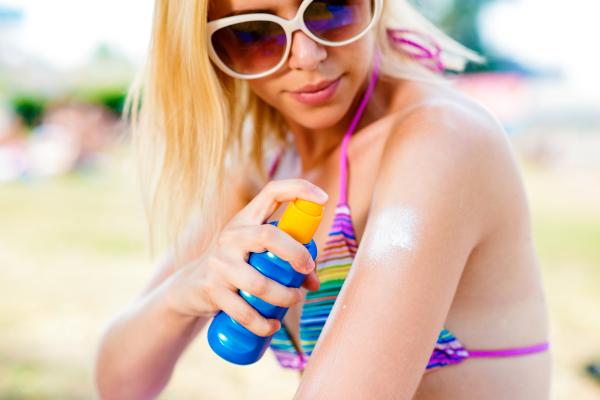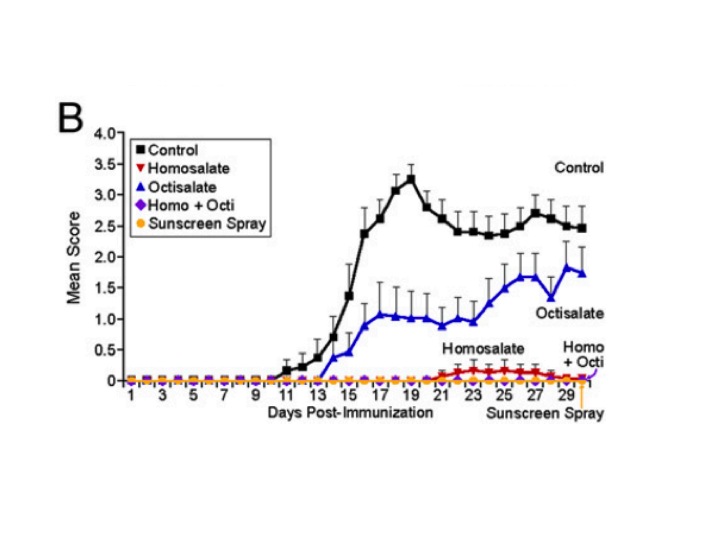
Sometimes, health advice is too good to be true. Eat pomegranates to prevent cancer. Organic food will make your kids smarter. Use sunscreen to treat an autoimmune disease.
What? Wait a minute - that last, as crazy as it sounds, just might be real.
A new study entitled "Salate derivatives found in sunscreens block experimental autoimmune encephalomyelitis in mice" published in Proceedings of the National Academy of Sciences reports that certain compounds found in sunscreens may help treat multiple sclerosis (MS). (1)
The researchers, from the University of Wisconsin-Madison, were working with an animal model designed to study MS called experimental autoimmune encephalomyelitis (EAE). This mouse, EAE, is a model of MS - meaning that they created a mouse to replicate what goes on in a human with MS, for the purpose of research. The mouse has demyelination of the central nervous system, just like people have when they have MS. The symptoms of EAE in the mouse are measured by the researchers on the following scale:
- 0 - no clinical disease
- 1 - loss of tail tone
- 2 - unsteady gait
- 3 - hind limb paralysis
- 4 - forelimb paralysis
- 5 - death
This mouse can be treated with drugs and compounds to see which ones have an effect on the symptoms, as a starting point to develop new treatments for humans with MS. Past findings have shown that UV radiation, specifically narrow-band (NBUVB) radiation at 300-315 nm has been shown to help alleviate the above symptoms in the EAE mouse.
The team in Madison was working on this project, exposing the mice to NBUVB. As part of the work, they were also using sunscreens. It was during one particular experiment that a very strange result occurred. The kind of result that makes a scientist turn to their colleague asking, "This can't be real... right?"
They found that the sunscreens alone blocked the EAE symptoms listed above from occurring.
The team worked with six brands of sunscreen (2). Four of them, Hawaiian Tropic, Coppertone Spray, Kiss My Face, and Blue Lizard produced significant suppression of the symptoms. The other two brands—Banana Boat and CoTZ Face—had no effect. This can be seen in the figure shown below. When looking at the figure, the lower the line on the graph, the fewer symptoms were observed. The black line labeled "control" represents the mice with the most EAE symptoms. The various colors represent the different sunscreen brands.

The four suncreens that had an effect were then analyzed for a common ingredient, to get to the bottom of which compound may be responsible for this result. The four sunscreens contained the salate derivatives homosalate and octisalate. Those compounds were then tested directly in the EAE mouse assay (see graph below). Not only did the researchers find that these compounds alone had the same effect, but, they also found that the effect was dose-dependent - meaning that the more compound they used in the experiment - the bigger effect they saw.

Before we go any further, let's clarify that - no - these compounds are not toxic. For more information on these specific compounds, please read my colleague Josh Bloom's article, "Sunscreen, MS And Endocrine Disruptor BS."
The experiment was set up to isolate the different players in the experiment. Because of this careful experiment design, this otherwise unbelievable result doesn't seem so hard to believe. One group of mice were exposed to UV rays every day for one month. A second group were mice exposed to UV every day for one month that also had sunscreen applied. The two other groups of mice were control groups - to ensure that the results of the experiment were able to be correctly interpreted. The third group were mice that had the sunscreen alone (no UV exposure) and (fourth) mice that had neither sunscreen nor UV exposure.
Now, I realize that this sounds like a story that, under other circumstances, I would be debunking. And, if not for the rigor of the study design and the convincing data, I would not believe this for a second. But, science is a crazy undertaking and sometimes crazy results happen. I'm glad that the researchers doing this experiment did not throw this result out, just because it was unexpected - something a less secure scientist may have done. From here, this paper may remain just that - a crazy result that goes nowhere. But, it also may be the start of a field that develops a new salate-derived therapeutic for MS.
Notes
(1) Multiple sclerosis is an autoimmune disease. The person's immune system attacks and destroys part of the body - in this case, the fatty sheaths that insulate nerve cells. People who have MS are weakened, can be physically disabled and may go blind. There is no cure for MS.
(2)




